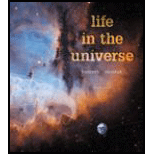
Scale of the Solar System. The real diameters of the Sun and Earth are approximately 1.4 million kilometers and 12,800 kilometers, respectively. The Earth–Sun distance is approximately 150 million kilometers. Calculate the sizes of Earth and the Sun, and the distance between them, on a scale of 1 to 10 billion. Show your work clearly.
Want to see the full answer?
Check out a sample textbook solution
Chapter 3 Solutions
Life in the Universe Plus Mastering Astronomy with Pearson eText -- Access Card Package (4th Edition) (Bennett Science & Math Titles)
Additional Science Textbook Solutions
College Physics: A Strategic Approach (4th Edition)
An Introduction to Thermal Physics
Physics for Scientists and Engineers: A Strategic Approach, Vol. 1 (Chs 1-21) (4th Edition)
Sears And Zemansky's University Physics With Modern Physics
Physics (5th Edition)
Conceptual Physical Science (6th Edition)
- Earlier in this chapter, we modeled the solar system with Earth at a distance of about one city block from the Sun. If you were to make a model of the distances in the solar system to match your height, with the Sun at the top of your head and Pluto at your feet, which planet would be near your waist? How far down would the zone of the terrestrial planets reach?arrow_forwardGive me the right answer please and thank you, take your timeCalculate the amount of time it takes for light reflected off the surface of a distant planet to reach us.1. Sunlight takes about 8.3 minutes to travel from the Sun to Earth. What is the Sun-Earth distance in AU? (Give your answer rounded to the nearest AU).2.Light is reflected off the surface of a planet 5.2 AU away from us. How long does it take this light to reach us from the planet? Give your answer in minutes, rounded to exactly one decimal place.arrow_forwardPlease answer the question and subquestions completely! This is one whole question which has subquestions! According to the official Bartleby guidelines, each question can have up to two subquestions! Thank you! 1) Use Kepler's Law to find the time (in Earth’s years) for Mars to orbit the Sun if the radius of Mars’ orbit is 1.5 times the radius of Earth's orbit. 1.8 2.8 3.4 4.2 A) The mass of Mars is about 1/10 the mass of Earth. Its diameter is about 1/2 the diameter of Earth. What is the gravitational acceleration at the surface of Mars? 9.8 m/s2 2.0 m/s2 3.9 m/s2 4.9 m/s2 none of these B) A 9.0 x 10 3 kg satellite orbits the Earth at the distance of 2.56 x 10 7 m from Earth’s surface. What is its period? 1.1 x 10 4 s 4.1 x 10 4 s 5.7 x 10 4 s 1.5 x 10 5 sarrow_forward
- Barnard’s Star, the second closest star to us, is about 56 trillion (5.61012) km away. Calculate how far it would be using the scale model of the solar system given in Overview of Our Planetary System.arrow_forwardExplain what is meant by the distance ladder in astronomy. Describe briefly how each “rung” of the distance ladder is calibrated so that a reliable measure of distance can be obtained using each of the methods. State clearly the range of distances that can be measured by each method that makes up the distance ladder.arrow_forwardDescribe the Nebular Theory. Include A) what it is, B)what happened, and C) at least three lines of evidence to support it.arrow_forward
- What do we mean by apparent retrograde motion of planets? Why was it difficult for ancient astronomers to explain? How do we explain it today?arrow_forwardNext you will (1) convert your measurement of the semi-major axis from arcseconds to AU, (2) convert your measurement of the period from days to years, and (3) calculate the mass of the planet using Newton's form of Kepler's Third Law. Use Stellarium to find the distance to the planet when Skynet took any of your images, in AU. Answer: 4.322 AU Use this equation to determine a conversion factor from 1 arcsecond to AU at the planet's distance. You will need to convert ? = 1 arcsecond to degrees first. Answer: 2.096e-5 AU (2 x 3.14 x 4.322 x (.000278/360) = 2.096e-5) Next, use this number to convert your measurement of the moon's orbital semi-major axis from arcseconds to AU. A) Calculate a in AU. B) Convert your measurement of the moon's orbital period from days to years. C) By Newton's form of Kepler's third law, calculate the mass of the planet. D) Finally, convert the planet's mass to Earth masses: 1 solar mass = 333,000 Earth masses.arrow_forwardEarth is about 150 million kilometers from the Sun (1 Astronomical Unit, or AU), and the apparent brightness of the Sun in our sky is about 1300 watts/m2. Using these two facts and the inverse square law for light, determine the apparent brightness that we would measure for the Sun if we were located at the following positions. a) At the orbit of Venus (67 million km from the Sun)arrow_forward
- What is comparative planetology and why is it useful to astronomers?arrow_forwardIf you observed the Solar System from the nearest star (distance = 1.3 parsecs), what would the maximum angular separation be between Earth and the Sun? (Note: 1 pc is 2.1105 AU.) (Hint: Use the small-angle formula in Reasoning with Numbers 3-1.)arrow_forward
 Horizons: Exploring the Universe (MindTap Course ...PhysicsISBN:9781305960961Author:Michael A. Seeds, Dana BackmanPublisher:Cengage Learning
Horizons: Exploring the Universe (MindTap Course ...PhysicsISBN:9781305960961Author:Michael A. Seeds, Dana BackmanPublisher:Cengage Learning Stars and Galaxies (MindTap Course List)PhysicsISBN:9781337399944Author:Michael A. SeedsPublisher:Cengage Learning
Stars and Galaxies (MindTap Course List)PhysicsISBN:9781337399944Author:Michael A. SeedsPublisher:Cengage Learning Foundations of Astronomy (MindTap Course List)PhysicsISBN:9781337399920Author:Michael A. Seeds, Dana BackmanPublisher:Cengage Learning
Foundations of Astronomy (MindTap Course List)PhysicsISBN:9781337399920Author:Michael A. Seeds, Dana BackmanPublisher:Cengage Learning AstronomyPhysicsISBN:9781938168284Author:Andrew Fraknoi; David Morrison; Sidney C. WolffPublisher:OpenStax
AstronomyPhysicsISBN:9781938168284Author:Andrew Fraknoi; David Morrison; Sidney C. WolffPublisher:OpenStax
 Stars and GalaxiesPhysicsISBN:9781305120785Author:Michael A. Seeds, Dana BackmanPublisher:Cengage Learning
Stars and GalaxiesPhysicsISBN:9781305120785Author:Michael A. Seeds, Dana BackmanPublisher:Cengage Learning





